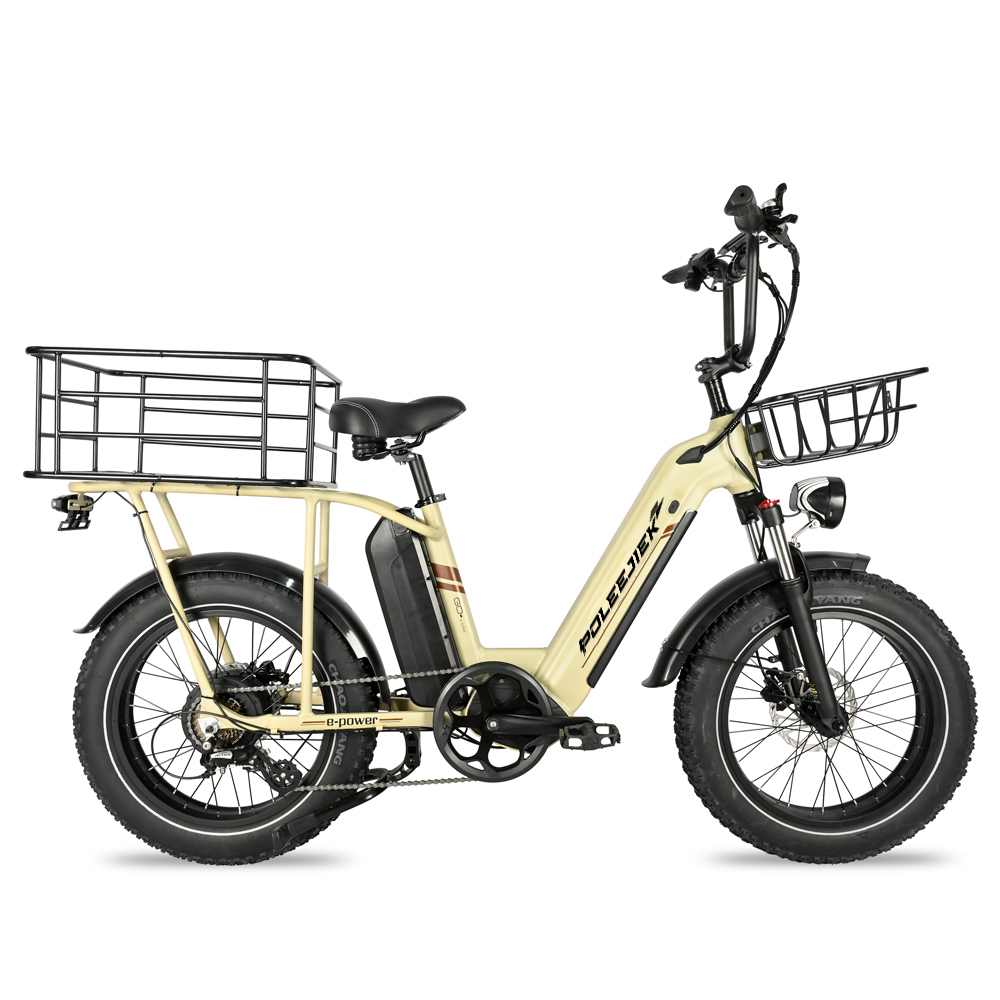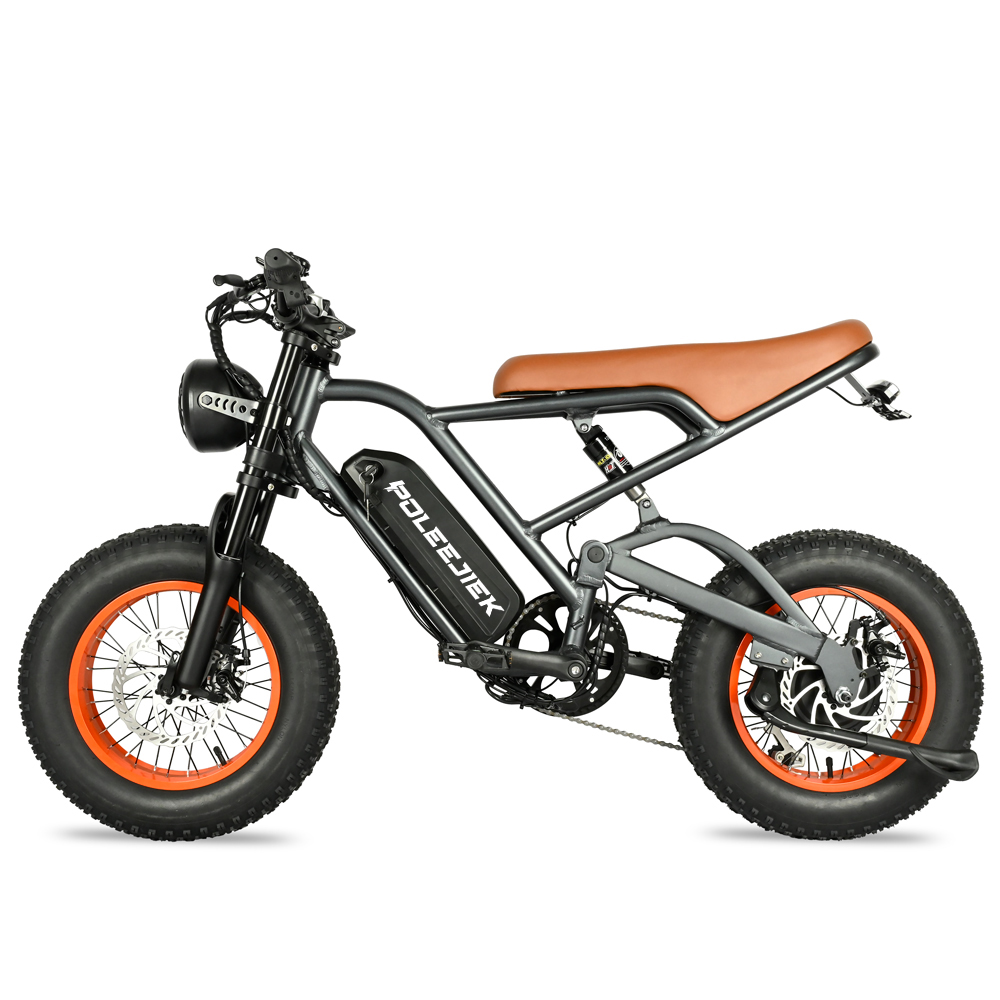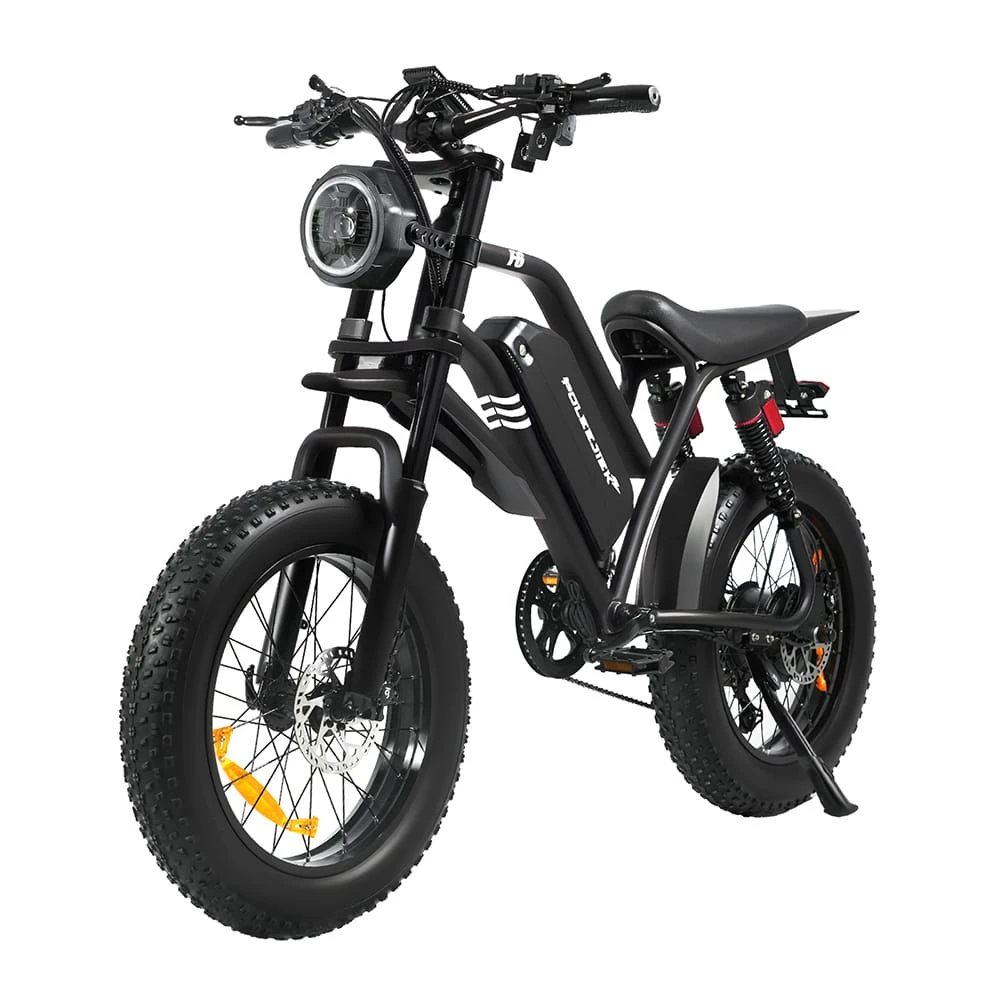What is a Street Legal Ebike? The B2B Guide to UL 2849 & US Law
Your B2C customer walks into a retail store and asks, "Do I need a license for an electric bike?"
It's a simple question. But as a B2B distributor, importer, or OEM partner, you must ask a much more expensive one: "Is this entire container of e-bikes legal for me to import and sell?"
The term "street legal" is thrown around cheaply by factories. On a sales sheet, it's a simple marketing bullet point. But at US Customs, in a CPSC recall notice, or in a product liability courtroom, it's a multi-million dollar word.
This is the central risk for B2B buyers in 2025. A simple labeling error, a misunderstood state law, or—most critically—a missing safety certification can lead to your entire shipment being seized, a nationwide forced recall, or catastrophic liability lawsuits from which your brand may never recover.
This is not a guide for retail consumers. This is a B2B operator's manual for navigating the complex, high-stakes world of US e-bike compliance. We will dissect the three distinct layers of what "street legal" truly means:
- CPSC Federal Law: The non-negotiable baseline for all bicycles.
- The 3-Class System: The traffic laws that define an e-bike vs. a motor vehicle.
- UL 2849: The fire safety standard that has become the new line of life and death for B2B brands.

Compliance Layer 1: The Baseline - CPSC 16 CFR 1512
Before you even discuss motor power or speed, you must ask: "Is this product legally a bicycle?"
In the United States, the answer is determined by the Consumer Product Safety Commission (CPSC). The mandatory federal standard is 16 CFR Part 1512 - Requirements for Bicycles.
The B2B Knowledge Point
This regulation was written for traditional bicycles, but it applies to all e-bikes that fall under the 3-Class system. It has nothing to do with the electrical system. Instead, it governs the mechanical integrity and basic safety features of the product.
As a B2B buyer, you must ensure your supplier can provide a General Certificate of Conformity (GCC) showing compliance with 16 CFR 1512. This is the absolute price of entry.
What Does 16 CFR 1512 Cover?
This is not a simple checklist. It involves rigorous physical and materials testing. Key requirements include:
- Braking Systems: The bike must be able to stop within a specified distance, with brake pad and lever integrity.
- Frame & Fork Integrity: The frame-fork assembly is subjected to repeated load and impact tests (the "fork-and-frame test") to ensure it doesn't fail catastrophically.
- Handlebars & Stems: Must withstand significant torque and stress to ensure a rider's steering inputs are secure.
- Reflectors: A full set of reflectors (front, rear, pedal, and wheel) is mandatory for visibility.
- Wheel & Tire Integrity: Ensures wheels are properly "trued" and tires can handle their rated pressure.
The B2B Significance: Many small, unvetted workshops or factories trying to break into the e-bike market skip this step to save costs. If you import a container of e-bikes that cannot pass these basic mechanical tests, your product is "illegal out of the box." It is fundamentally non-compliant, and a single mechanical failure reported to the CPSC can trigger a full investigation and recall.
Compliance Layer 2: The Core - The 3-Class System
This is the layer most people think of when they say "street legal." The 3-Class system is the legal framework, adopted by a majority of US states, that defines an electric bike and separates it from a moped, scooter, or motorcycle.
It is 100% your responsibility as the importer to ensure the e-bike is manufactured, tested, programmed, and—most importantly—labeled according to these classes.
What is a Class 1 Ebike?
-
Definition: A
class 1 ebikeprovides motor assistance only when the rider is pedaling (pedal-assist ). The motor stops providing assistance when the bike reaches 20 mph. - B2B Angle: This is the "safest" and most widely accepted category. Class 1 e-bikes are generally permitted in the same places traditional bicycles are, including most multi-use bike paths. For B2B partners targeting recreational riders or path-heavy urban areas, a Class 1 e-bike is a stable, low-risk inventory choice.
What is a Class 2 Ebike?
-
Definition: A
class 2 ebikeis equipped with a throttle that can power the motor without the rider pedaling. The motor stops providing assistance (from the throttle or pedal-assist) when the bike reaches 20 mph. - B2B Angle: This class is extremely popular in the US market for its utility, accessibility, and ease of use. However, it carries a distinct compliance risk. You must verify with your supplier that the throttle and the pedal-assist are both strictly governed to cut off at 20 mph.
What is a Class 3 Ebike?
-
Definition: A
class 3 ebikeprovides motor assistance only when the rider is pedaling (pedal-assist), but continues until the bike reaches 28 mph. - Critical Note: Most states prohibit Class 3 e-bikes from having a throttle. They must also be equipped with a functional speedometer.
- B2B Angle: This is the high-performance commuter class. Its primary advantage is speed for "car replacement" commuting. Its primary disadvantage is regulatory fragmentation. Many states and municipalities restrict Class 3 e-bikes from multi-use paths and bike lanes, limiting them to road use only. As a B2B partner, you have an obligation to educate your distributors and retailers on these local restrictions.
B2B Buyer Alert: A Mislabeled Sticker is a Legal Disaster
This is the single most common compliance failure. A factory, either through error or a desire to please a buyer, will put a "Class 2" sticker on a bike that can be "unlocked" to 25 mph or has a 1000W motor.
This is a legal catastrophe.
The moment that "Class 2" bike goes over 20 mph, it is no longer an e-bike in the eyes of the law. It is an unregistered, uninsured, and illegal motor vehicle.
- If a rider is pulled over, the bike can be impounded.
- If a rider is in an accident, their insurance (and yours) will be void.
- This mislabeling constitutes fraud and gross negligence, opening your company (as the importer of record) to immense lawsuits.
You must have a quality control (QC) process to verify that the bike's software and hardware (controller, motor ) are locked to the class specified on the label.
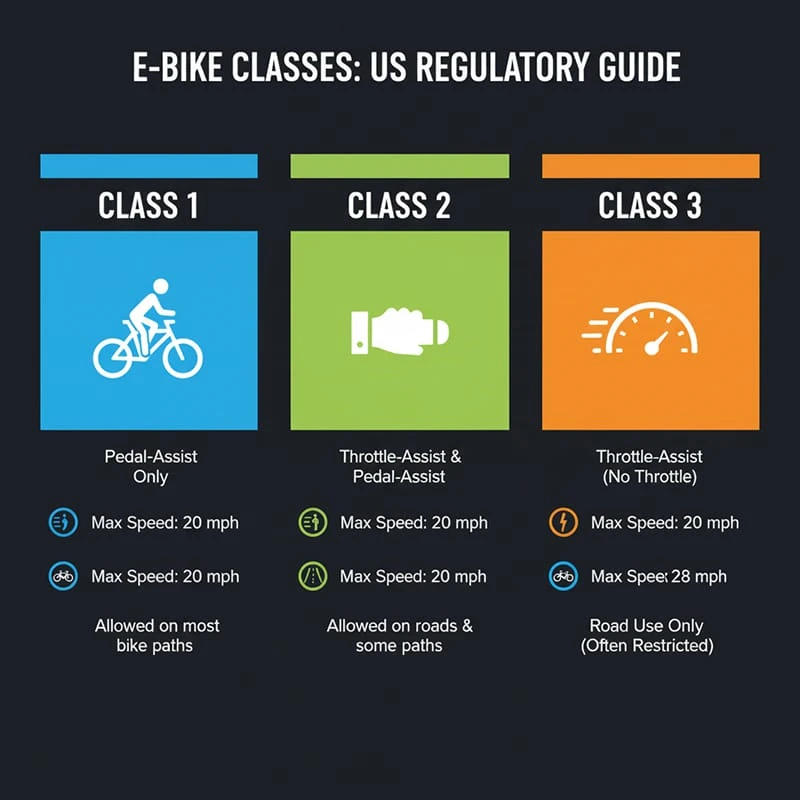
Compliance Layer 3: The Red Line - Why UL 2849 is the B2B “Line of Life and Death”
You can be 100% compliant with CPSC 16 CFR 1512 and the 3-Class system and still have your business destroyed by a single event: a lithium-ion battery fire.
This brings us to the third and most important layer of modern compliance.
"Street Legal" Does Not Equal "Fire Safe"
The CPSC and 3-Class laws solve the "traffic law" problem. UL 2849 solves the "property and fire safety" problem.
For a B2B distributor or brand, a battery fire is the ultimate nightmare. It’s a 24/7 news story, a multi-million dollar recall, and an existential threat to your brand's reputation. This is not a hypothetical risk; it is the single biggest pain point in the industry today, and regulators are responding with force.
What is UL 2849? Why is it Critical for B2B?
UL 2849, "Standard for Electrical Systems for E-Bikes," is the comprehensive safety standard for the entire e-bike electrical system.
It is not a "parts" certification. It is a "system" certification. This means an independent national laboratory (like UL, TÜV, or SGS) tests the battery, charger, motor, and controller together as a complete ecosystem.
The certification process is brutal and expensive. It includes:
- Functional Safety: Ensures the system's software (the BMS, or Battery Management System) works as intended, shutting down properly if it detects over-voltage, under-voltage, or high temperatures.
- Environmental Tests: Subjects the system to water ingress (rain and spray), vibration, and shock tests.
- Mechanical Tests: Includes crush, impact, and drop tests on the battery pack.
- Electrical Tests: Dozens of tests for short-circuiting, overcharging, and forced discharge.
- Charger-Battery Mismatch: Critically, it tests what happens when the wrong charger is used.
B2B Reality: This is no longer optional. New York City has passed Local Law 39, legally mandating that all e-bikes sold, leased, or rented in the city must be certified to UL 2849. Other cities and states are following suit. This is the new baseline for ebike import regulations and ebike battery safety standards.
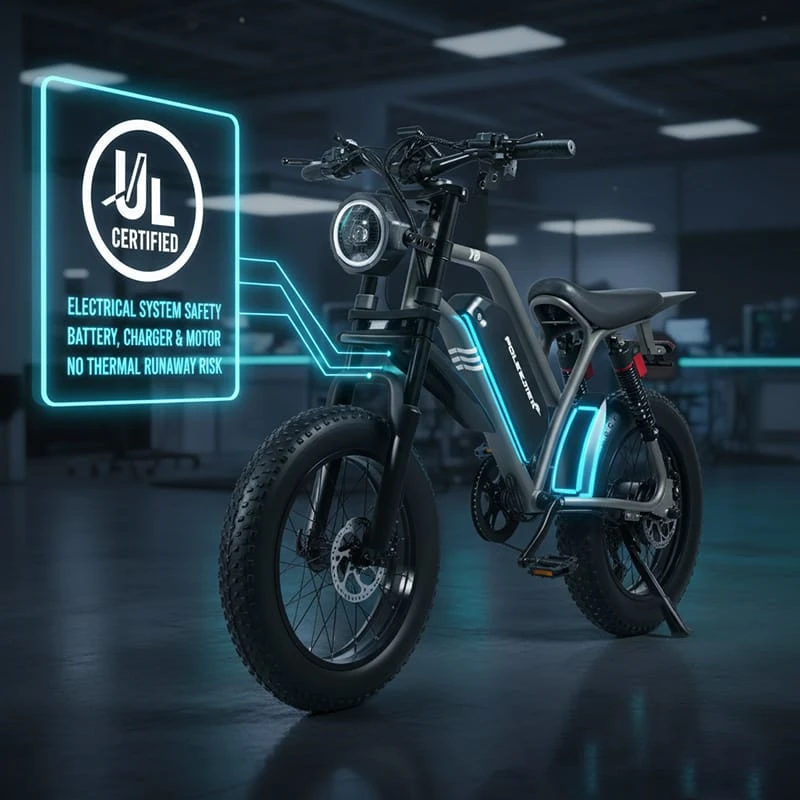
The Ultimate Buyer Trap: “UL-Certified Battery” vs. “UL 2849-Certified Ebike”
This is the most common and deceptive trap B2B buyers fall into.
You will ask a supplier, "Is this bike UL certified?" They will say, "Yes, of course. We use UL-certified cells."
This is a meaningless and dangerously misleading statement. Using UL-certified cells (e.g., Samsung, LG, Panasonic) is a good start, but it is NOT UL 2849 compliance.
- Cell Certification (e.g., UL 1642): Tests only the individual, raw battery cell.
- Battery Pack Certification (e.g., UL 2271): Tests the completed battery pack and its BMS. This is better, but still incomplete.
- E-Bike System Certification (UL 2849): Tests the battery, charger, and controller working together in the final product.
A poorly designed controller or a cheap charger can easily cause a perfectly good battery pack to fail and catch fire. Only UL 2849 verifies that the entire system is "fire safe."
When you source from Poleejiek, you are sourcing a full-system UL 2849 certified e-bike. This is the only true guarantee of safety and compliance that protects your business.
The Special Category: Compliance for the Electric Dirt Bike (Critical!)
There is massive consumer demand for the street legal electric dirt bike. This product category represents a huge opportunity, but it is also a compliance minefield.
Why the Electric Dirt Bike for Adults is a "Red Zone"
The B2B reality is this: Most electric dirt bikes are NOT e-bikes.
They are "electric motorcycles" or "off-road recreational vehicles." They do not fit the 3-Class system. Their motors are too powerful (e.g., 3000W-5000W), and their speeds are too high (e.g., 40-50 mph ).
To be truly "street legal" as a motorcycle, they must meet US Department of Transportation (DOT) and NHTSA standards, which require:
- A Vehicle Identification Number (VIN)
- Headlights, tail lights, brake lights, and turn signals
- DOT-approved tires and mirrors
- The rider must have a motorcycle license, registration, and insurance.
How B2B Buyers Can Safely Sell in this Category
You have two clear, safe, and honest paths to market.
Path A: "Off-Road Only" (The Honest Path) Market the product for what it is: a high-performance off road ebike or electric motorbike. This is the simplest and safest legal strategy. All marketing, manuals, and sales agreements must explicitly state "For off-road or private property use only. This vehicle is not street legal." This absolves you of the liability for on-road use.
Path B: The "Hybrid" E-Bike (The Compliant Path) To create a street legal electric dirt bike (that is legally an e-bike), you must design a product that strictly adheres to the 3-Class system.
- It must be power-limited to 750W (nominal).
- It must be speed-limited to 20 mph (Class 2) or 28 mph (Class 3, pedal-assist only).
- It must have all required CPSC 16 CFR 1512 mechanical components.
- It must be certified to UL 2849 for the entire electrical system.
Poleejiek specializes in helping our B2B partners navigate this exact distinction. We can provide true off-road-only models, or we can co-design fully compliant, UL-certified, "dirt bike-style" Class 2 and Class 3 e-bikes that are safe and legal to sell for on-road use.
Conclusion: The B2B Buyer's Compliance Checklist (The B2B Action Plan)
Do not risk your business on a supplier's verbal promise of "Don't worry, it's street legal."
As a professional B2B buyer, you must demand proof. Before your next PO, ask your supplier these three questions:
- "Can you provide the General Certificate of Conformity (GCC) for CPSC 16 CFR 1512?"
- "What is your QC process to guarantee the bike's software and hardware functions strictly match the Class 1, 2, or 3 label?"
- "Can you provide the full system UL 2849 Certificate of Compliance for this entire bike from a Nationally Recognized Testing Laboratory?"
If they hesitate on any of these three, you are taking on a massive, unnecessary risk.
Your Call to Action
At Poleejiek, compliance isn't a marketing term; it's our core manufacturing standard. We believe our B2B partners deserve the peace of mind that comes from sourcing a product that is safe, legal, and profitable.
Contact us now to get Poleejiek' complete, UL 2849-certified product catalog and our B2B compliance whitepaper. Let's ensure your next shipment is a success, not a liability.




